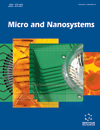- Home
- A-Z Publications
- Micro and Nanosystems
- Previous Issues
- Volume 5, Issue 4, 2013
Micro and Nanosystems - Volume 5, Issue 4, 2013
Volume 5, Issue 4, 2013
-
-
Effect of Template on Microstructural and Optical Properties of ZnO:Al:Mo Films Deposited by Sol-Gel Route
More LessTransparent conductive ZnO:Al:Mo films with a constant molar ratio of Zn: Al: Mo=99:0.99:0.01 were deposited on quartz glass substrate by a template-assisted sol-gel process and characterized by X-ray diffraction, atomic force microscopy, and UV-vis and luminescent spectrophotometries. The organic templates in precursor solution have induced the formation of nanorod microstructure with different Read More
-
-
-
Analytical Modeling of Slip Flow in Parallel-plate Microchannels
More LessAuthors: Navid Kashaninejad, Weng Kong Chan and Nam-Trung NguyenThis paper presents analytical modeling of slip liquid flow in parallel-plate microchannels, and can be divided in two parts. In the first part, classical relationships describing velocity, flow rate, pressure gradient, and shear stress are extended to the more general cases where there exist two different values of the yet-unknown slip lengths at the top and bottom walls of the channel. These formulations can be used to experime Read More
-
-
-
Synthesis of Mn Vanadate Microrods and Their Photocatalytic Properties
More LessMn vanadate microrods have been synthesized via a simple hydrothermal method using Mn acetate and sodium metavanadate as the raw materials, polyvinyl pyrrolidone (PVP) as the surfactant. X-ray diffraction (XRD) and scanning electron microscopy (SEM) observations show that the Mn vanadate microrods are composed of monoclinic MnV2o6 phase. The diameter of the microrods increases from 250 nm to 1µm with Read More
-
-
-
Fabrication of Nano Electrodes based on Liquid Membrane Electrochemical Etching
More LessAuthors: Yongbin Zeng, Xiujuan Wu, Ningsong Qu and Di ZhuElectrochemical machining has the potential to allow machining at the nanometer scale. A nano electrode is an essential tool in nano-electrochemical machining. In this paper, the mechanism of liquid membrane electrochemical etching is studied, and a processing platform is developed. The processing voltage, initial tungsten diameter and electrolyte concentration are control factors in nano electrode fabricat Read More
-
-
-
New Optical Properties of Porosity Layer Controlled by Laser-Induced Etching
More LessAuthors: Khalid Omar, Asmiet Ramizy, Khaldun A. Salman and Z. HassanThree different power densities and fixed irradiation times have been used to prepare porous silicon using laserinduced etching process to control the size and shape of nanostructure. There are new optical properties of porous silicon. Scanning electron microscopy was used to study surface morphology after the etching process. Porous silicon was characterized using spectroscopic studies. There is shift in Raman peak positio Read More
-
-
-
Nanosuspension: A Potential Nanoformulation for Improved Delivery of Poorly Bioavailable Drug
More LessNanotechnology is the study, design, creation, synthesis, manipulation, and application of functional materials, devices, and delivery systems through control of matter at the nanometer scale. These include nanovectors, nanotubes, nanosensors, nanowires and nanocantilever arrays, nanopores and nanoformulations. These advances will lead to significant applications relevant to the diagnosis, management, and in the Read More
-
-
-
Nanoparticle as An Emerging Tool in Pulmonary Drug Delivery System
More LessAuthors: Priya V. Patel, Tejal G. Soni, Vaishali T. Thakkar and Tejal R. GandhiThe advent of nanotechnology has reignited interest in the lungs as a major route of drug delivery for both systemic and local treatments. As the end organ for the treatment of local diseases or as the route of administration for systemic therapies, the lung is a very attractive target for drug delivery. The large surface area and the minimal barriers impeding access to the lung’s periphery make this organ a suitable portal for a Read More
-
-
-
Scaling Laws for Damping Forces Exerted by Different Gases in the Near- Free Molecular Flow Regimes
More LessAuthors: A. Bonucci and S. LorenzaniShear- and pressure-driven gas flows are encountered in several Micro-Electro-Mechanical-Systems (MEMS) applications, where the fluid is usually trapped under or around the vibrating micromechanical structure in extremely narrow gaps. The thin gas film is responsible for damping in these oscillating microstructures and its properties are of great importance to design, optimize and fabricate improved minute devices. Under Read More
-
Most Read This Month
Article
content/journals/mns
Journal
10
5
false
en


